Woodyard D. (ed.) Pounders Marine diesel engines and Gas Turbines
Подождите немного. Документ загружается.

690 Wärtsilä
optimized constant pressure valve design for short injection period and high
brake mean effective pressure; no mixing of lubricating oil and fuel between
plunger and barrel to avoid lacquering and sticking; separation of leakage fuel
from the oil sump to avoid lubricating oil contamination; integrated low-pressure
fuel supply lines; fuel injection valves with uncooled nozzles; and shielded high-
pressure lines and connections. The fuel injection system is fully covered by the
hot box, and possible low- and high-pressure leakages are detected by alarms.
The fuel pump has an integrated low-pressure channel which means there
is no low-pressure pipe to fit to the pump because the fuel pipes are fitted
directly to the fuel pump foundation. Integrated fuel pulse dampers in the fuel
supply lines ensure low-pressure pulses on the system side. Each fuel pump
is equipped with a flow distribution throttle. The high-pressure fuel pipe is
shielded and fitted with a leak alarm. Maintenance is facilitated by a locking
device flange on the cylinder head for the high-pressure pipe.
The engine starting system incorporates a starting fuel-limiter to secure a
smooth and safe start. Each fuel pump is equipped with an overspeed trip cyl-
inder to ensure that the fuel rack is pushed to zero in the event of overspeed.
Additional safety is provided by an extra stop cylinder turning the regulating
shaft to zero in the event of overspeed. Overall compactness and lightness were
prime targets for the W38 engine designers. Component integration resulted in
40 per cent fewer parts than the older generation TM410 engine, with many of
the traditional bolted-on elements now incorporated in the main block casting
(for example, lines and piping for lubricating oil, cooling water and fuel).
Simplicity of maintenance and extended overhaul intervals were other
design goals, with only a modest envelope required for servicing and dis-
mantling. Engine-driven cooling and lubricating oil pumps as well as engine-
mounted coolers and filters simplify installation and release machinery space.
Integrated brackets are provided for resilient mounting systems. The bending
stiffness and torsional rigidity of the engine block and crankshaft allow savings
in the specification of flexible couplings, torsional vibration dampers and elas-
tic elements for resilient mounting.
W38A Specication
Engine block: underslung crankshaft; integrated air receiver; single-piece cast-
ing for all cylinder numbers; and arranged for resilient mounting with screwed-
on feet.
Crankshaft: fully balanced and designed for space saving, maximum over-
all rigidity and moderate bearing loads. The crankshaft of the V-cylinder mod-
els has undercuts for both the main and pin fillet, the design combining a short
cylinder distance and maximum bearing length. Normal fillets are applied in
the in-line cylinder engines.
Connecting rod: marine head design, completely machined and dimen-
sioned to achieve the lowest dismantling height (Figure 27.18).
Bearings: Thick-pad bearing technology and moderate main bearing load.
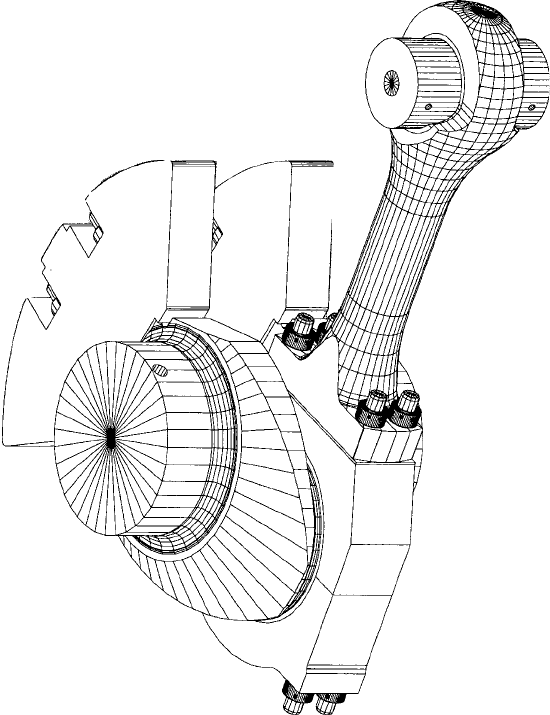
Cylinder liner: high-collar design with optimized operational roundness
and straightness; bore cooling for effective control of liner temperature; and
anti-polishing ring.
Piston and rings: composite piston with forged steel crown and nodular
cast iron skirt; pressurized skirt lubrication; two ceramic chromium-plated
directional barrel-shaped compression rings in the crown; a ceramic chromium-
plated taper-faced compression ring and an oil distributor ring in the skirt.
Cylinder head: stiff box with four screws; flame plate supported by inter-
mediate deck, allowing no deformation of valve seat environment.
Camshaft: single-cylinder shaft segments with integrated cams; and built-in
valve tappet modules screwed onto the engine block.
Turbocharger/charge air cooling: modular exhaust gas pipes in insulated
hot box; two-stage air cooler; and integrated, rigid turbocharger support/charge
air cooler.
Figure 27.18 Wärtsilä 38 engine connecting rod
Wärtsilä 38 691
692 Wärtsilä
W38B Version
The popularity of the Wärtsilä 38 encouraged the development of a B-version
offering higher powers with lower fuel consumption and reduced emissions.
The new model also benefited from an advanced control and monitoring sys-
tem, and full modularization to ease assembly. The B-series was fully released
in 2001 with in-line six, eight and nine and V12-, 16- and 18-cylinder models
covering a power band from 4350 kW to 13 050 kW at 600 rev/min. The V18-
cylinder model was subsequently dropped, lowering the upper output of the
programme to 11 600 kW. Two specific ratings are now offered: 675 kW/cyl-
inder (25.1 bar mep) and 725 kW/cylinder (26.9 bar mep). The original engine,
re-designated the Wärtsilä 38A, remained in the programme for a while, both
versions assigned for production at Wärtsilä Italia in Trieste.
Careful selection of thermodynamic processes and progress in component
design contributed to the achievement of the development goals. The refinements
included a higher maximum cylinder pressure, compression ratio and mean effec-
tive pressure, and advanced fuel injection timing (see p. 693). Special attention
was paid to optimizing the combustion chamber characteristics, the fuel injection
profiles and the piston shape. The air flow system was fully revised (inlet bends
to the cylinder head, flow channels at the head, port design, exhaust bends and
turbocharger). State-of-the-art valve timing (including application of the Miller
cycle) was also introduced. New generation turbochargers were adopted to fur-
ther boost overall performance and economy, with integration of the bypass and
waste gate valves. The position of the valves and their controls was selected to
secure low vibration levels, low local temperatures and short pipework.
These measures resulted in a significant reduction in specific fuel con-
sumption (6 g/kW h below the 38A engine) and opened the way to further
improvements in fuel economy. The limits on pollutant emissions were also
comfortably met; the NOx emission levels can be lowered further by up to 50–
60 per cent by incorporating direct water injection (see Chapter 3).
Critical components were given greater strength to support the higher
power levels and raise the safety margins for further rating growth; examples
include additional strengthening of the connecting rod and geometrical modifi-
cations at the interface of the cylinder liner with the cylinder head (area of the
gas sealing ring). All bearing loads are kept low and an ample oil film thick-
ness ensures safe bearing operation.
A new three-piston ring pack and an anti-polishing ring incorporated at the
top of the cylinder liner foster low lube oil consumption. The ‘hot box’ envi-
ronment was completely redesigned to secure high reliability and functional
integration; externally, there are swinging hot box covers and new cylinder
head covers enclosing the hot box area; internally a new LP and HP fuel sys-
tem is based on a new generation pump.
The lubrication module incorporates a cooler, an automatic back-flush fil-
ter, a centrifugal filter in the back-flush line and thermostatic valves. The over-
all system includes main and pre-lubrication pumps and the regulating valve.
Lubricating oil flow through the engine was revised and based on optimized

bearing clearances to allow large safety margins. Running-in filters of the spin-
on type can be mounted on the non-operating side of the engine and removed
after the factory approval test. The LT and HT cooling water systems embrace
pumps and thermostatic valves built on the engine.
Compactness and easier installation were promoted by ‘all on’ engine sup-
port systems, with complete lubrication and cooling water modules mounted
on the engine (Figure 27.19). All piping connections are located at the free end
to allow simplified interfacing with external systems. Among the advanced
automation features is Wärtsilä’s WECS 7000 engine-integrated system, which
is tailored for the group’s medium-speed designs.
Wärtsilä 38A and 38B dierences
38A 38B
Bore
380 mm 380 mm
Stroke 475 mm 475 mm
Output/cylinder 660 kW/cyl 725 kW/cyl
Cylinders 6, 8, 9L/12, 16, 18V Same
Speed
600 rev/min 600 rev/min
Compression ratio 12.7 15
Maximum combustion
pressure
180 bar 210 bar
Mean eective pressure 24.5 bar 27 bar
Piston speed 9.5 m/s 9.5 m/s
injector holes 11 10
injector position ref 6 mm higher
Fuel cam ref Low speed
Cylinder head
ref Optimized air ow
Piston shape
ref Optimized
inlet valve timing ref Miller cycle
injection timing ref Advanced
exhaust system ref Optimized ow
Turbocharger eciency 65 per cent 70 per cent
Specic fuel consumption
ref 6 g/kW h
NOx emissions iMO iMO-50 per cent
*
*
Prepared for direct water injection
Wärtsilä 38 693

694 Wärtsilä
WärTSiLä 46
Several innovative features were introduced by Wärtsilä Diesel with the launch
of the W46 engine in 1988 which became popular in diverse passenger and
cargo ship propulsion sectors (Figures 27.20 and 27.21). The designer’s prime
development goal in creating a large bore medium-speed trunk piston engine
to compete with low-speed crosshead machinery was the highest reliability. A
significant contribution was sought from thick-pad bearing technology, exploit-
ing large bearings with thick oil films, and pressure-lubricated piston skirts.
During its first 4 years of production the 460 mm bore/580 mm stroke
design was offered with an output of 905 kW/cylinder at 450/500/514 rev/min
as the Wärtsilä 46A. Experience with pilot installations encouraged the release
in 1992 of a B-version with an output of 975 kW/cylinder at 500/514 rev/min.
The C-output version followed in autumn 1995, yielding 1050 kW/cylinder
at 500/514 rev/min with reduced thermal load and lower emissions thanks to
advances in turbocharging and fuel injection systems and the adoption of low
NOx combustion principles.
The three ratings allow the 46 series to cover a power band from 5850 kW
to 15 600 kW with six, eight and nine in-line and V12- and V16-cylinder mod-
els. The C-output versions operate with mean effective pressures up to 28.8 bar
and the engine is designed for a maximum combustion pressure of 210 bar.
A nodular cast iron engine block (Figure 27.22) is configured to achieve a
rigid and durable construction for flexible mounting (the W46 engine was per-
haps the first of its size designed for elastic and super-elastic mounting, Figure
27.23). The main bearings are of the underslung type with hydraulically tight-
ened bolts; side bolts add further rigidity to the main bearing housing. In-line
cylinder engines are equipped with an integrated air receiver fostering rigidity,
CAC HT
CAC LT
HT pump
HT standby
HT in
LT standby
LT in
LT out
HT out
Lub. oil
standby
LT pump
Lub. pump
Pre-lub. pump
M
Centrifugal
filter
Lub. oil
filter
Lub. oil
cooler
Figure 27.19 integrated cooling water and lubrication oil systems of W38B engine
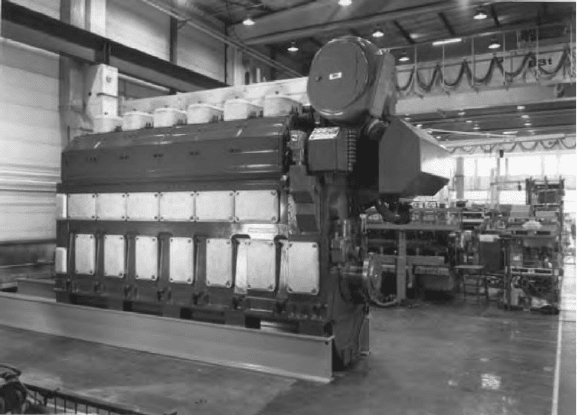
simplicity and cleanliness. A welded block of steel castings and plates is
offered as an alternative.
A rigid box-like cylinder head design aims for even circumferential contact
pressure between the head and cylinder liner, with four fixing bolts simplify-
ing maintenance procedures. No valve cages are used, improving reliability
and increasing the scope to optimize exhaust port flow characteristics. Water-
cooled exhaust valve seat rings are specified. Both inlet and exhaust valves
receive a forced rotation from Rotocaps during every opening cycle, fostering
an even temperature distribution and wear of the valves, and keeping the seal-
ing surface free from deposits, resulting in good heat conduction.
Cylinder liner deformations are normally caused by cylinder head clamping
and thermal and mechanical loads. A special liner design with a high collar-to-
stroke ratio for the W46 engine minimizes deformation, the round liner bore in
combination with efficient lubrication enhancing conditions for the piston rings
and reducing wear. The liner material is a special grey cast iron alloy developed
for wear resistance and high strength. An anti-polishing ring in the upper part of
the liner prevents the bore polishing that leads to local liner wear and increased
lubricating oil consumption. The simple yet highly effective device was intro-
duced as standard on later engines and retrofitted to existing installations.
A composite low-friction piston with a nodular cast iron skirt and steel
crown incorporates a special cooling gallery configuration to secure efficient
cooling and high rigidity for the piston top. It is designed to handle combus-
tion pressures beyond 200 bar. A long lifetime is sought from hardened top ring
grooves. The three-ring set includes a top ring with a special wear-resistant
coating; all the rings are dimensioned and profiled for maximum sealing and
Figure 27.20 Six-cylinder version of the Wärtsilä 46 engine
Wärtsilä 46 695
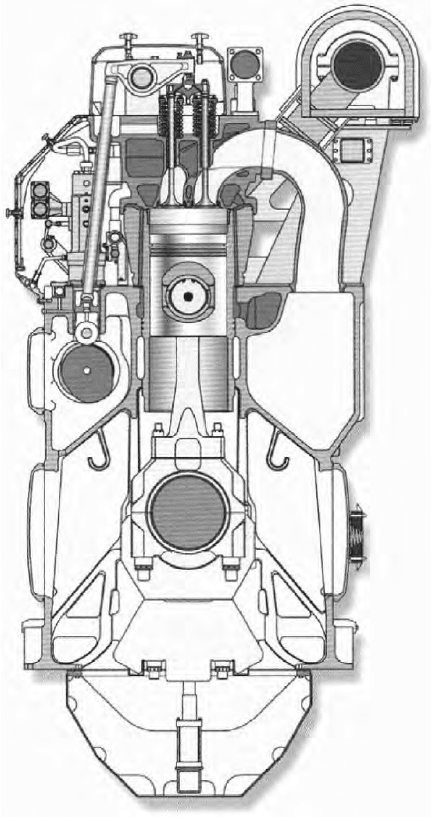
696 Wärtsilä
pressure balance. Low friction is addressed by a skirt lubrication system deliver-
ing a well-distributed clean oil film that eliminates the risk of piston ring scuff-
ing and reduces the wear rate, and fostering cleaner rings and grooves free from
corrosive combustion products. Noise and wear are reduced by hydraulically
damped tilting movements provided by an oil pad between liner and piston.
Hard skirt contact against the liner experienced with the first seagoing W46
engine installation was solved by introducing a piston with increased compres-
sion height, a slightly increased skirt length and an optimized skirt form.
A three-piece marine design connecting rod was designed for distribution of
the combustion forces over a maximum bearing area with relative movements
Figure 27.21 Cross-section of Wärtsilä 46 engine
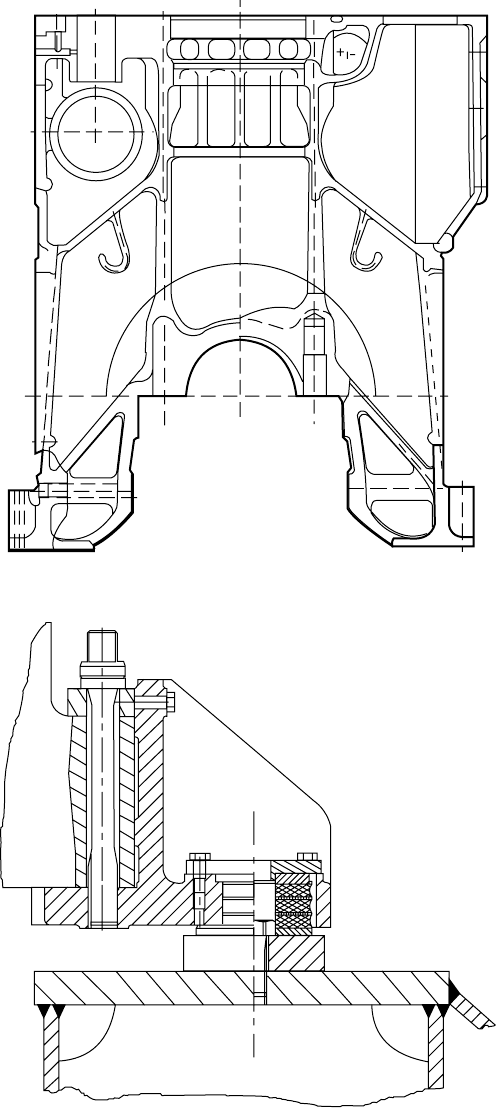
Figure 27.22 engine block of Wärtsilä 46 engine
Figure 27.23 Flexible mounting system for Wärtsilä 46 engine
Wärtsilä 46 697
698 Wärtsilä
between mating surfaces minimized. Piston overhaul is facilitated without
touching the big end bearing, and the bearing can be inspected without remov-
ing the piston. The three-piece design also reduces the piston overhauling
height.
The one-piece forged crankshaft is designed to accept a high combustion
pressure while maintaining a conservative bearing load; rigidity is under-
written by a moderate bore/stroke ratio and large pin and journal diameters.
Counterweights fitted on every crank web provide 95 per cent balancing.
Reliability is sought from the thick-pad bearing design and bearing loads
reduced by increasing crankshaft journal and pin diameters as well as length.
Low bearing loads allow for softer bearing materials with greater conformabil-
ity and adaptability, underwriting a virtually seizure-free bearing, according to
Wärtsilä. A thick corrosion-resistant overlay of tin–antimony is used in the big
end bearings.
The key elements of Wärtsilä’s thick-pad bearing technology are: ample oil
film thicknesses achieved by proper overall dimensioning; corrosion-resistant
bearing materials with excellent embeddability properties; radially rigid bear-
ing assemblies during both mass and gas force loading conditions; conform-
able bearing materials and axially conformable housings, which minimize edge
pressure; and oil grooves and oil holes located where no harm can be caused to
the oil film.
The camshaft is built of single-cylinder sections with integrated cams. The
shaft sections are connected through separate bearing journals which make
it possible to remove the sections sideways from the camshaft compartment.
The valve follower is of the roller tappet type, the roller profile being slightly
convex for good load distribution. The valve mechanism includes rocker arms
working on yokes guided by pins.
W46 Fuel injection
An innovation on the original W46 engine was a twin injection fuel system
exploiting a pilot valve and a main injection valve (Figures 27.24 and 27.25).
The initial aim of the system was to secure safe combustion with the poorest
fuels on the market; the very fast main injection process facilitated by the sys-
tem also contributed to a low fuel consumption. It became evident too that the
twin injection configuration yielded a positive effect on NOx emissions, stimu-
lating further refinement of the system.
The first seagoing W46 engine installation was later optimized with a
reduction of the pilot fuel amount to below 3 per cent. Both pilot and main
injection valves were designed with a small heat absorbing surface facing the
combustion space and arranged for efficient heat transfer to the cooling water,
eliminating the need for a separate nozzle temperature control system. Fuel
was transported over the shortest distance from the pump to the valve via a
high-pressure pipe in the cylinder head.
Wärtsilä cited the following merits of twin injection through individually opti-
mized nozzles: excellent pilot fuel atomization and combustion over a wide load
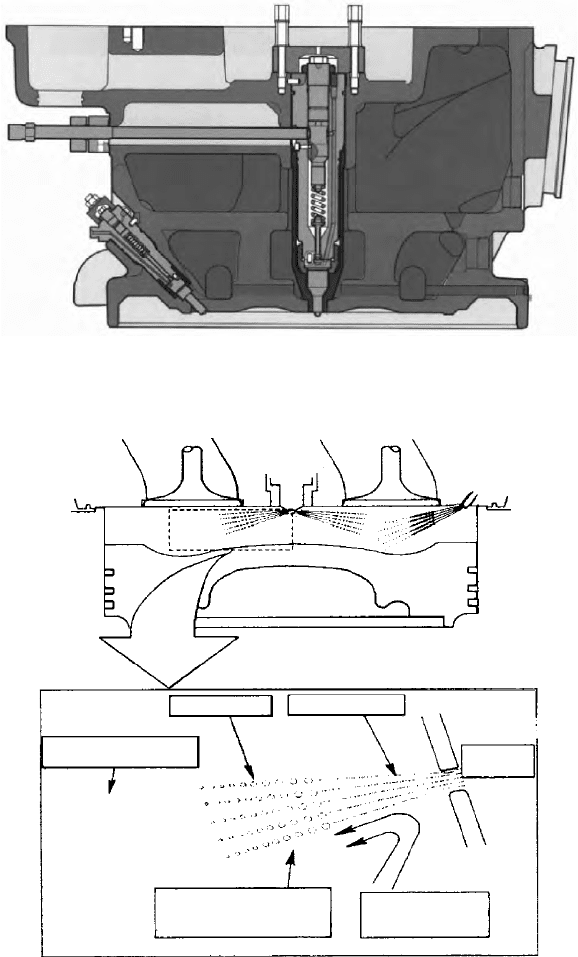
and speed range; reasonable injection rates even under idling conditions when the
combustion process is often a poor compromise; facility to burn fuels of low igni-
tion quality with a minimum of ignition delay; low combustion noise level thanks
to controlled pre-burning, resulting in a lower rate of increase in cylinder pressure
Figure 27.24 Wärtsilä 46 twin injection system, showing the pilot fuel valve (left)
and the main fuel valve (centre)
Pilot
injection
Main
injection
Liquid fuel jet
Atomized fuel
Injection
nozzle
Premixed combustion after
ignition delay
Air entrainment nozzle-
induced recirculation
Diffusion combustion following
premixed combustion
Figure 27.25 Twin injection system principle for original Wärtsilä 46 engines
Wärtsilä 46 699
